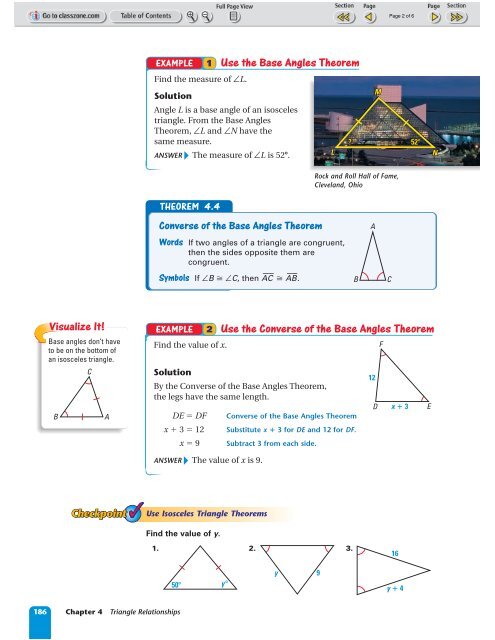4.3 Isosceles and Equilateral Triangles
4.3 Isosceles and Equilateral Triangles
4.3 Isosceles and Equilateral Triangles
Create successful ePaper yourself
Turn your PDF publications into a flip-book with our unique Google optimized e-Paper software.
Visualize It!<br />
Base angles don’t have<br />
to be on the bottom of<br />
an isosceles triangle.<br />
B<br />
C<br />
A<br />
186 Chapter 4 Triangle Relationships<br />
EXAMPLE 1 Use the Base Angles Theorem<br />
Find the measure of aL.<br />
Solution<br />
Angle L is a base angle of an isosceles<br />
triangle. From the Base Angles<br />
Theorem, aL <strong>and</strong>aN have the<br />
same measure.<br />
ANSWER The measure of aL is 52.<br />
THEOREM 4.4<br />
Converse of the Base Angles Theorem<br />
Words If two angles of a triangle are congruent,<br />
then the sides opposite them are<br />
congruent.<br />
Symbols IfaBcaC, then AC &*cAB &*.<br />
Find the value of x.<br />
Solution<br />
By the Converse of the Base Angles Theorem,<br />
the legs have the same length.<br />
DE DF Converse of the Base Angles Theorem<br />
x 3 12 Substitute x 3 for DE <strong>and</strong> 12 for DF.<br />
Find the value of y.<br />
1. 2. 3.<br />
50<br />
x 9 Subtract 3 from each side.<br />
ANSWER The value of x is 9.<br />
y<br />
y<br />
9<br />
A<br />
B C<br />
EXAMPLE 2 Use the Converse of the Base Angles Theorem<br />
Use <strong>Isosceles</strong> Triangle Theorems<br />
LL<br />
?<br />
Rock <strong>and</strong> Roll Hall of Fame,<br />
Clevel<strong>and</strong>, Ohio<br />
12<br />
MM<br />
D<br />
F<br />
Page 2 of 6<br />
x 3<br />
16<br />
y 4<br />
52 52<br />
E<br />
NN


